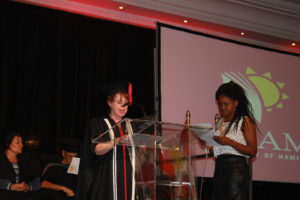On April 24, 2015, the first class of students graduated from the B.Pharm program at the University of Namibia (UNAM)–the first and only pharmacy degree program in the country. With the help of the USAID-funded SIAPS program, the Namibian Ministry of Health and Human Services was able to conceive, establish, and encourage enrollment in the B.Pharm degree. The graduation of the country’s first locally educated pharmacists constitutes a major step forward in alleviating the country’s dire shortage of pharmacy staff and helping to meet the health care needs of the largely underserved Namibian population.
In 2003, the HIV/AIDS epidemic in Namibia peaked at a prevalence rate of 17%. Lowering the infection rate and expanding access to treatment for people living with HIV required a rapid nationwide scale-up of pharmaceutical services and delivery systems. Coupled with the country’s vastness and sparse population, efforts to expand availability of antiretroviral medicines (ARVs) placed added stress on an already overburdened workforce and health care system.
A key impediment to the scale-up of pharmaceutical services in Namibia was the shortage of skilled pharmaceutical personnel. Guided by the USAID-funded Rational Pharmaceutical Management Plus (RPM Plus) Program’s 2003 assessment of Namibia’s public pharmaceutical sector, the Ministry of Health and Social Services (MoHSS) realized that the scale-up of pharmaceutical services needed to be matched with adequately trained human resources. The long-term sustainability of pharmaceutical provision in Namibia required developing the capacity of local institutions to train pharmacists and pharmacist assistants.

A shortage of trained Namibian pharmacists
According to The World Health Report 2006, 288 pharmacists were registered in Namibia in 2004, translating to a density of just 14 pharmacists per 100,000 people. This immense gap in human resources was attributed to high vacancy rates, as well as limited pharmaceutical posts in the public sector, rapid workforce turnover and a reliance on foreign pharmacists. There was a severe deficiency in the availability of qualified and experienced Namibians holding pharmaceutical posts. Of the 48 established posts for pharmacists within the MoHSS, Namibians staffed only five of the 31 filled positions. Overall, foreigners on two- to three-year contracts held almost 90% of the filled pharmacist positions nationwide.[1]
Early on in the start-up and scale-up of the antiretroviral therapy (ART) program, it was reported that pharmacy staff lacked the knowledge to appropriately manage ARVs or to provide adequate counseling to patients on the administration of medicines. Although Namibia already had the capacity to train nurses, counselors and pharmacist assistants, enabling the ART program to achieve optimum reduction in morbidity and mortality required the skilled oversight of a pharmacist experienced in areas such as pharmaceutical care, adherence monitoring, adverse drug effects and the analysis of treatment data to guide decision-making. According to a 2003 study by RPM Plus, only 33% of facilities surveyed kept a record of prescriptions dispensed and 8% of prescriptions written, while just 17% of the facilities assessed had a system for monitoring drug use.The MoHSS’s Pharmaceutical Services Division lacked the human resources required to cope with the scale-up and decentralization of ART services, relying on pharmacist assistants responsible for pharmaceutical service provision at the facility level.
A critical challenge to pharmaceutical human capacity development in Namibia was the absence of a local institution to train pharmacists and the lack of student awareness and interest in the study of pharmacy. To address the gap, it became imperative to offer high-quality pharmaceutical training through a local university. Of 515 students pursuing science and health social welfare-related training programs at the University of Namibia (UNAM) in 2003/04, only about 0.3% chose to further their studies in pharmacy. To change students’ mindsets and enhance their interest in pharmacy, the pharmacy profession needed to be promoted and accepted as an integral part of a well-structured health care system.
Finding a sustainable solution
In collaboration with the MoHSS and University of Namibia (UNAM), the USAID-funded Strengthening Pharmaceutical Systems (SPS) Program explored the feasibility and needs associated with establishing a pharmacy degree at UNAM in 2009, building on the existing School of Medicine training platform. The report emphasized the necessity of modifying national human resources (HR) policies, engaging strong local leadership, and involving key international stakeholders. Overall, the report recommended that immediate steps be taken to establish a Bachelors of Pharmacy (B.Pharm) degree to reduce the country’s reliance on foreign pharmacists in the coming years for all its health needs, and for the HIV response in particular.
Supported by funding from USAID, local and international stakeholders came together between February and May 2010 to expedite the creation of a B.Pharm degree to be initially offered under UNAM’s newly created School of Medicine. A technical working group, comprised of representatives from MoHSS, USAID/SPS and UNAM, the Health Professions Council of Namibia (HPCNA), the Pharmacy Council of Namibia and the Pharmaceutical Society of Namibia, provided technical input on the development of a competency framework, qualification and curriculum for the B.Pharm degree. Though it was specifically developed for relevance in the Namibian context, the competency framework and curriculum were rigorously evaluated against international and regional standards for pharmacy education. The curriculum was further reviewed during a National Consultative Forum chaired by the Minister of Health and Social Services and the Vice Chancellor of UNAM and by a working group comprised of experts from international universities, including the University of Washington, University of the Western Cape and University of Zimbabwe.
The B.Pharm curriculum and standards for qualification of pharmacists was submitted and approved by the UNAM Senate in September 2010. To become an accredited higher-education program, the B.Pharm program was submitted for accreditation to the Health Professions Council of Namibia (HPCNA) and the Namibia Qualifications Authority (NQA). The program received its accreditation by HPCNA and NQA in 2011. As a nationally accredited program, the pharmacy program was officially launched on March 10, 2011, with 24 students enrolling as first-year students. Prior to 2011, the only option for domestic pharmaceutical training was through a two-year certificate level course at the National Health Training Center (NHTC).

Shaping the future of UNAM’s School of Pharmacy
After briefly housing the B.Pharm degree within the SOM’s Department of Pharmacy, UNAM approved the creation of a School of Pharmacy in 2012. To facilitate the establishment of the School of Pharmacy and its faculty, USAID funded two senior lecturer positions: the associate dean and the head of department. These two positions have since been absorbed by UNAM as teaching staff. By offering high-level pharmacy education in Namibia, the university will contribute to the sustainability of ART programs and pharmaceutical services nationwide.
Since 2012, the USAID-funded Systems for Improved Access to Pharmaceuticals and Services (SIAPS) Program has been instrumental in providing technical support to UNAM’s School of Pharmacy as it strives to meet Namibia’s need for trained pharmaceutical personnel. SIAPS has continued to strengthen the pre-service training of pharmacy students by providing curriculum implementation frameworks, instructor’s guides and student materials on pharmaceutical supply management, pharmacoeconomics, pharmacovigilance, rational medicine use, and antimicrobial resistance. In consultation with the School of Pharmacy’s 10 faculty members and other key stakeholders, SIAPS facilitated the development of a five-year strategic plan for the further development of the school according to its three pillars: teaching, research and community service. Most recently, SIAPS supported the UNAM’s School of Pharmacy in developing and launching a two-year, part-time pharmaceutical technician course, providing career progression for trained pharmacist assistants. Creating further opportunities in pharmacy, the course was launched in February 2015 with an initial enrollment of 30 students.
Since the four-year B.Pharm program was introduced, there has been a gradual increase in student enrollment every year, illustrating the growing interest and awareness in the study of pharmacy in Namibia. As of July 2014, 107 pharmacy students were enrolled in UNAM’s B.Pharm degree, 14 of whom graduated in April 2015. With a new influx of locally trained pharmacists, the review of the MoHSS’s HR policies is more critical than ever for ensuring that the country’s public health system benefits from the introduction of advanced pharmacy instruction.
Creating opportunities for Namibians to study pharmacy at UNAM’s School of Pharmacy will quickly alleviate the nationwide shortage of pharmacists. With key contributions from USAID-sponsored programs, Namibia, through the establishment of UNAM’s School of Pharmacy, is closer to achieving its 2030 vision of having a strong science and technology educational base with a flexible curriculum and new teaching methodologies. As students advance through UNAM’s B.Pharm curriculum, Namibia will see a reduction in the staff vacancy rate, balanced workloads at ART dispensing sites and an improvement in ART service delivery, moving towards patient-centered pharmaceutical care, preventing child and maternal deaths and achieving an AIDS-free generation in Namibia.
AUTHORS: By Timothy Rennie,1 Dan Kibuule,1 Lischen Haoses-Gorases,1 Peter Nyarang’o,1 David Mabirizi,2 Evans Sagwa,2 Dinah Tjipura,2 Greatjoy Mazibuko,2 Katelyn Payne,2 Rosalia Indongo3 and Bayobuya Phulu2
AFFILIATIONS: 1. University of Namibia; 2. Systems for Improved Access to Pharmaceuticals and Services (SIAPS). 3. USAID Namibia
The authors would like to acknowledge the following people for their hard work in the process of creating the B.Pharm curriculum and program for the University of Namibia (UNAM): Mr. Jude Nwokike, Dr. Tina Brock, Mr. Lewis Durango, Ms. Hazel Bradley, Prof. Mahama Duwiejua, Dr. Eric Woode, and Prof. Andy Stergachis. Appreciation also goes to Professor Lazarus Hangula and the leadership of the University of Namibia, former Minister of Health and Social Services Dr. Richard Nchabi Kamwi and MoHSS management for their unwavering support in the development of this program. Last but not least, the authors acknowledge the overwhelming support of the Government of the Republic of Namibia and in particular Dr. Sam Shafishuna Nujoma: Founding Father and Founding President of the Republic of Namibia for his foresight and vision to have locally trained Pharmacists and Medical Doctors.
[1] Mabirizi D, Lates J, Sagwa E, Haoses-Gorases L, Nwokike J, Pereko D, Kalemeera F, Kawonga J, Mwansasu A. 2011. Strengthening Human Resources for Pharmaceutical Service Delivery in Namibia: From Short-Term Interventions to Long-Term Sustainability. Submitted to the U.S. Agency for International Development by the Strengthening Pharmaceutical Systems (SPS) Program. Arlington, VA: Management Sciences for Health.

